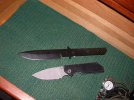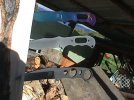Thanks for the complement Darrel!
Can you explain a bit about this new coating, without giving away proprietary secrets of course. I am sure we are all a bit curious as to the process a blade must go through to get the coating.
Also folks I tried my best to scratch this stuff. I took my Tachyon from my neck and ran the tip down the surface. It left a mark that was removed by rubbing my finger. The mark was from my knife and NOT the coating.
My research shows the following that Darrel my be able to elaborate on for use on knives.
The mechanical and tribological properties of DLC films (friction coefficient around 0.1 in air, hardness up to about 80 GPa, and elastic modulus approaching 600 GPa) are very close to those of diamond. Moreover, these films are chemically inert in most aggressive environments, and may be deposited with densities approaching that of diamond. However, differently to CVD diamond, DLC films are routinely produced at room temperature, which makes them particularly attractive for applications where the substrate cannot experience elevated temperatures.
DLC simply means Diamond Like Carbon (coatings). It is harder than Ti coatings and MUCH hard than chrome or chromium nitrides.
DLC thin-film is produced in the high-vacumn environment inside the a machine's chamber by a physical vapor deposition (PVD) process. During the PVD process, benzene is disassociated and ionized by a DC arc discharge (plasma). The resulting ions migrate towards the blade to be coated which is negatively biased relative to the plasma. Collisions between ions in the gas phase result in the formation of both SP2 and SP3 bonded carbon structures which are then deposited on the substrate surface. As this is a PVD process, no chemistry takes place on the substrate surface and, thus, the substrate temperature can be less than 200 degrees Celcius.
DLC thin-film has an amorphous structure which is lacking in crystal grains. DLC has a much smoother surface than TiN. DLC has an average roughness of 7 angstroms whereas a typical TiN film has an average roughness of 110 angstroms. This exceptional smoothness, along with hardness, results in DLC's superior tribological properties as well as other properties such as wear-resistance, chemical inertness, build-up resistance, and low friction coefficient.
The above is a AST scan of the surface of a DLC coating.
Below is a TiN coating scan.
As you can see DLC is MUCH smoother.
The results of a ball-on-disk tribology test is shown below. This test measures the friction coefficient between the ball and coated disk as well as the diameter of the wear spot on the ball. The test consists of rotating a disk which has been coated with the thin-film to be tested under a stationary ball with a given load applied. An aluminum ball was used in this test. The materials tested included WC-Co (uncoated), DLC, TiN, CrN, TiCN, TiAlN thin-films. As shown below, the DLC thin-film out-performed the other materials for both friction coefficient and ball wear.
The result of applying a DLC coating to a knife blade is obvious. You get a KICK ASS result!
Anyway the info above was compiled by me and may be slightly different than what Bodycote's numbers.
Hope this helps!





